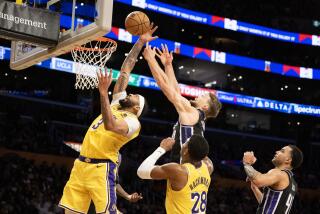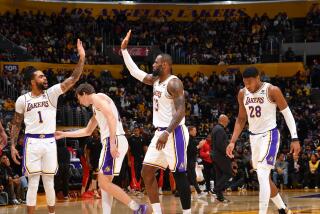City of angles
- Share via
It’s the triangle offense, now available in version 3.0.
These days, Kobe Bryant offers an alley-oop Pau Gasol’s way and the two can exchange roles the very next play. Luke Walton posts up, then drifts out for a three-point shot, or Lamar Odom ducks and dives his way to the rim for enough double-doubles to fill his heart’s content.
The part-mystical, part head-scratching triangle offense is functioning quite smoothly with Gasol completing the Lakers’ trifecta.
Possibly more so than . . . Michael Jordan’s championship days under Phil Jackson?
“Since we’ve had Gasol, it’s a very good comparison,” said Tex Winter, a Lakers consultant and a pretty smart person to ask on the subject because, well, he is the offense’s innovator. “It’s not necessarily a guy like Kobe or Michael Jordan that oftentimes makes the difference in this. Sometimes, it is the post man or someone else.”
At 86, Winter is a basketball lifer and a walking encyclopedia. He played for USC under Hall of Fame coach Sam Barry, who created the premise of the triangle offense, with Winter later smoothing its edges during his more than half a century of coaching. His coaching jobs included Marquette, Kansas State, Northwestern, Long Beach State and the NBA’s San Diego Rockets. He became a Chicago Bulls assistant in 1985.
When the Bulls named Jackson their coach in 1989, he brought the triangle in to do away with too many isolation plays for Jordan. The Bulls ran it to six championships. After Jackson and Winter moved to the Lakers, the Shaquille O’Neal-Kobe Bryant teams won three titles, and the Bryant-Gasol squad is hoping to get another ring.
The triangle offense revolves around reads and reaction, rhythm and rotations. Its basic principles include penetration through ball entry at the high post, with spacing and cuts predicated off the pass.
One key component is that players are interchangeable and should be able to play any position. If worked to precision, Winter says, a player should always be open.
And every good scheme contains a bailout plan.
The final option of the offense is having a Jordan or Bryant available to go one-on-one should all else fail.
The triangle is created by the center in the post, a forward at the wing and a guard in the corner. The weak side features a guard at the top of the key and a forward who are free to play a two-man game should the ball rotate there.
From there it’s all cuts and ball movement and can get complicated. Winter, after all, did write a book on it in 1968.
Still, depending on who’s talking, the triangle offense is either easily digested or only mastered by Mensa members. It’s perfectly suited for the NBA or it’s too scripted and stifles creativity.
“When you have guys [play it] with such great spacing, such good recognition, great passing, it makes the game fun to watch,” Bryant said.
Winter insists the triangle offense can be absorbed quickly through practice and patience, enough so that he advises junior high school coaches to teach it. Still, many a pro has struggled grappling its intricacies. Gary Payton, anyone?
“If it’s presented to them right and if they’ve got some basketball knowledge and basketball savvy, some players learn it in no time and other people will never learn it,” Winter said.
The Milwaukee Bucks, New Jersey Nets and Indiana Pacers use some parts of the triangle offense and the Phoenix Suns threw in some wrinkles of it after acquiring O’Neal.
But Jackson and Winter’s teams have been the only ones in the NBA to run it exclusively.
The reasoning, said Craig Hodges, who played under Winter at Long Beach State, won two championships as a guard with the Bulls and is now a Lakers assistant, is partly out of pride of not wanting to duplicate another system and partly because so few know the offense enough to teach it. Skeptics note that any offense looks pretty smart with a Jordan or Bryant as its driving force.
“Their main thing is you can’t use what you don’t know,” Hodges said. “I’ve seen teams complimenting Tex by using part of the system, but they’ll run it more as a play opposed to running it off of reads.”
Through the Jackson-Winter years, there have been tweaks to the triangle offense, but it is always run to highlight a team’s strengths.
In Chicago, Ron Harper, a big guard, would frequently post up. Centers Luc Longley and Bill Cartwright were adept at feeding the ball, instead of scoring.
And of course, Jordan and Scottie Pippen maintained a rather fluid two-man game.
“It’s actually 40% physical and 60% is mental. You have to make reads that other systems don’t lend themselves to,” Hodges said.
Jackson said those Bulls teams still hold the edge on running the offense efficiently, but the gap may be closing. “There’s a certain recognition that came along with a little more precision, perhaps, with the Bulls, but they never had the interior presence that we have had on these teams here in L.A.,” Jackson said.
In the Kobe-Shaq era, the offense tended to be an entry pass into the post. Everyone would make a cut and often, play dissolved into one-on-one matches. Another three championships were amassed. And the offense was as Winter preferred, dominated through the post.
“With Shaq, we were forced, at times out of respect and out of the fact that he got great results for us, we pounded the ball inside against anybody we played against,” Derek Fisher said.
Fast forward to this Lakers team. Andrew Bynum seemed poised to become the system’s dominant big man until his injury. Then Gasol came, playing as if years ago Winter had cultivated the offense just for him.
“The system works really well when you know how to play this game and make the right plays,” Gasol said.
“Know when to shoot. When to pass. Know where to be on the floor. I always took pride in being a great basketball player and having a good basketball IQ and no matter what type of system you are in, you just adjust to it real quick and I’ve always been able to adjust quick to any type of system.”
What is most surprising, Fisher says, is Gasol’s versatility in posting up to the basket to complement his mid-range jump shot.
“With the teams that we had in the past, we obviously had that big guy [O’Neal] in the middle, so a lot of stuff that we ran funneled through him and then we got back to the triangle after that,” Bryant said. “The team that we have now relies more on spacing, ball movement, everybody being a threat. It’s just more to the principles of what the triangle is.”
There are still times when the Lakers’ offense launches 30-plus three-pointers in a game -- an occurrence that never would have happened had O’Neal still been in the middle.
But all in all, it has been a while since the triangle offense has showcased angles this right, corners this edgy.
“Our offense it still predicated on getting penetration,” Fisher said, “and having Pau Gasol helps a great deal and whether Andrew Bynum is back this season or starting up again next season, for years to come, we have guys that can be the focal point of getting the ball inside and that’s when we are at our best.”
--
--
(BEGIN TEXT OF INFOBOX)
Principles of the triangle offense
Tex Winter’s seven principles of the triangle offense:
1. Penetration -- Accomplished by throwing the ball into the post.
2. Spacing -- Between 15-20 feet separating each player. It leaves players open if the defense double teams, creating open shots.
3. Player movement with a purpose -- Sharp cuts to the basket that create easy scoring chances.
4. Offensive rebounding and defensive balance -- With defenses having to shift to compensate the movement, seams are created to slip in for putbacks. Defensive balance allows the players to transition easily back into defense and avoid fastbreak points.
5. Interchangeability -- The offense allows for any player on the court to fill any role in the offense.
6. Read the defense -- The ballhandler should be able to find any one of his teammates. The initial pass goes to the first open player.
7. Utilize individual talents -- If all else fails, it’s nice to have Michael Jordan or Kobe Bryant to bail the play out.
More to Read
All things Lakers, all the time.
Get all the Lakers news you need in Dan Woike's weekly newsletter.
You may occasionally receive promotional content from the Los Angeles Times.








